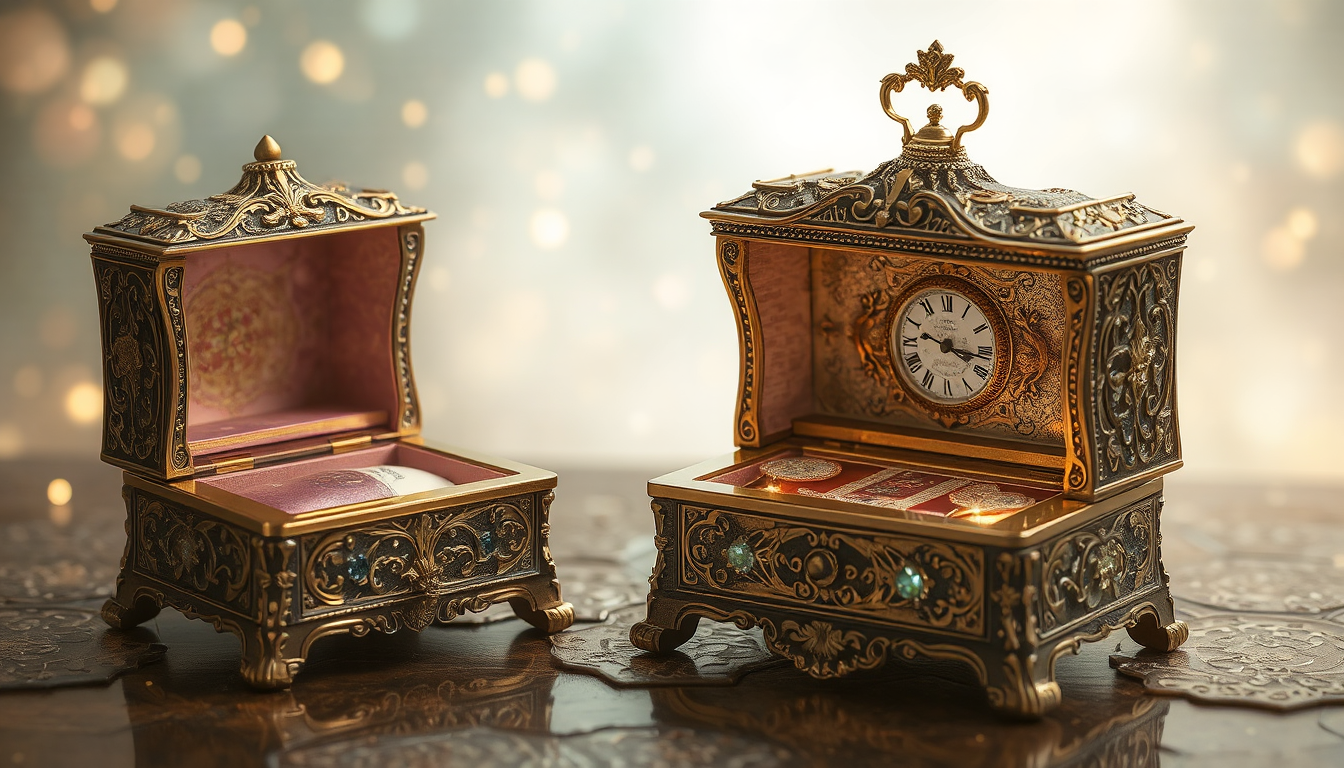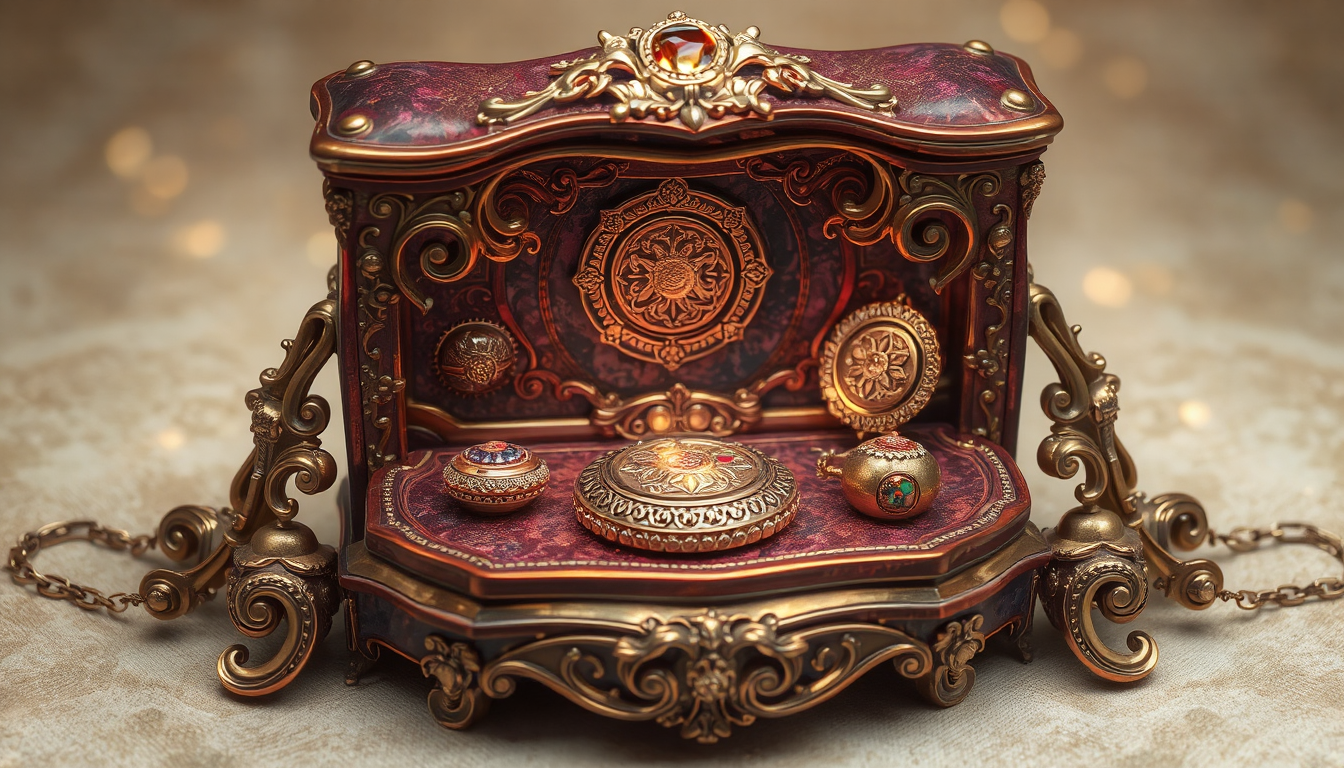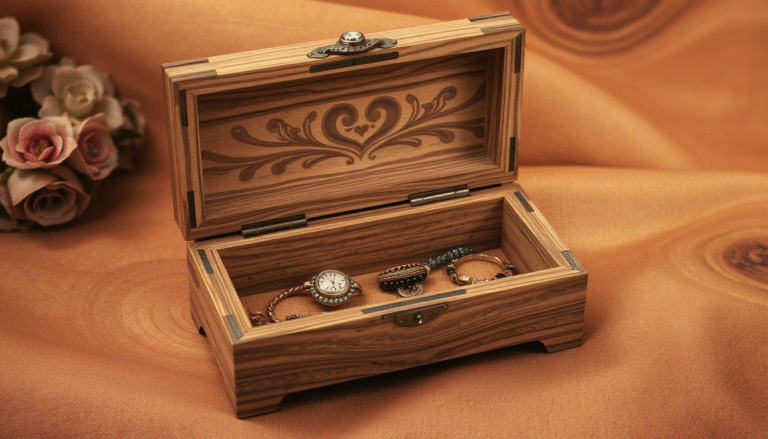Introduction: The Quick Answer to a Common Question
If you imagine a musical jewelry box, you might think of a traditional wooden box with a twirling ballerina. No Battery Operated, Most of the traditional music boxes do not need the battery. Many newer models with more bells and whistles do require batteries.
The power source is wholly dictated by the type of musical works concealed within. One depends on centuries-old mechanical skills and the other on modern electronics.
In this explainer, we’ll take an in-depth look at both. We will help you differentiate between the two varieties, figure out which kind you have and learn how best to treat your item.
The Charm of Tradition: The Wind-Up, Battery-Free Musical Box

The most common and beloved type of musical jewelry box works without a single battery. This is the classic, timeless version that has been passed down through generations.
You can easily identify a traditional musical box by its key feature: a small metal winding key. This key is usually found on the back or bottom of the box, though sometimes it’s placed inside.
The mechanism of it’s operation is a classic example of simply mechanics. As you turn the winding key, you are winding up an internal spring, which stores energy. When the lid is opened, it sets a small stopper free, and the spring’s power is used to turn a pinned metal cylinder. As it turns, its little pins drag across the teeth of a steel comb, which produces a sweet, shimmering melody.
No, the engagement with a physical box is a big part of what makes them charming in our experience. The key provides slight resistance as you turn it, until you hear a solid “click” as the spring inside is fully wound. Totally acoustic and soft, It does not sound anything like a digital speaker. It’s a nostalgia that places you, directly, into that object.
Naturally, a classic design like this one has its own set of pros and cons.
-
Pros:
-
Timeless Charm: It has an authentic, nostalgic appeal that electronics can’t match.
-
No Ongoing Costs:No more batteries to purchase, and no more to replace.
-
Durability: The simple, robust mechanism can last for decades, often becoming a family heirloom.
-
Environmentally Friendly: It uses no electricity or disposable batteries.
-
Cons:
-
Limited Music: It has fixed melody, can not be converted.
-
Short Playtime: It only plays for a minute or two per wind.
-
Mechanical Wear: Due to long time use (such to ten or fifteen years the transmission may experience wear out or get out of the tune.
The Modern Twist: When Musical Jewelry Boxes Do Need Batteries
We still love the tinkle and click of an old music box in so many of them, but the age of the wind up music box has given way to that of the musical jewelry box that doesn’t need winding. These electronic interpretations have features not physically possible in mechanical movements.
If your box can do any of the following, it is almost certainly battery-powered.
Key Features Requiring Power
-
LED Lighting: Another feature that many of the recent versions include is LED lighting, flashing inside of the jukebox in time to the music.
-
High-Fidelity Digital Audio: Rather than a tine, these boxes play music with a digital sound chip and a tiny speaker. This lets them play high-quality, sound-treated clips of hit songs — many from blockbuster movie soundtracks, such as Frozen or Harry Potter.
-
Multiple or Custom Songs: More advanced models are also able to store multiple songs, giving you multiple options of what you want your visitors to hear. Some even accept USB ports or SD card slots to play your own MP3 files.
-
Motion or Light Sensors: A traditional box often works by a basic lever mechanism that triggers the music but an electrical one could have a light sensor or magnetic switch that activates when the lid is opened.
Common Battery Types
The type of battery needed depends on the box’s design and features. We most commonly see standard AA or AAA batteries for larger boxes with more power-hungry features like lights and speakers. For more compact or sleek designs, you’ll often find small, flat CR2032 button cells, similar to those used in watches.
Just like their mechanical counterparts, these battery-powered boxes have their own benefits and drawbacks.
-
Pros:
-
Superior Sound Quality: Digital audio is clearer and more complex than a mechanical tune.
-
More Variety:You get more music options, and even selections you can customize every now and then.
-
Modern Features: Lights and other effects can give that “wow” especially good for children.
-
Cons:
-
Battery Dependency: Since you will be required to change the batteries every once in a while, it will be spending over time.
-
Electronic Failure: Circuit boards and speakers can fail, and are typically more difficult to repair than mechanical movements.
-
Battery Corrosion: If batteries are left in too long, they can leak and do damage.
-
Lacks Classic Charm: There are those who prefer the sound coming from an actual turntable, which carries a more traditional “feel” to it.
At a Glance: Wind-Up vs. Battery-Powered Jewelry Boxes

To make things even clearer, we’ve put together a simple table. This will help you quickly identify what kind of box you’re looking at or decide which type is right for you.
| Feature | Traditional Wind-Up Box | Modern Battery-Powered Box |
| Power Source | Mechanical (wound spring) | Batteries (AA, AAA, button cells) |
| How to Activate | Open the lid (after winding) | Open the lid, press a button |
| Music Style | Single, fixed melody; metallic tune | Digital audio, multiple/custom songs |
| Extra Features | Typically none; dancing figurine | LED lights, sound effects, motion sensors |
| Maintenance | Dusting; avoid overwinding | Battery replacement; check for corrosion |
| Lifespan | Can last for generations | Limited by electronic component life |
A Look Inside: Understanding The Mechanism That Makes the Music
To truly appreciate your musical jewelry box, it helps to understand the beautiful engineering that powers it. Whether mechanical or electronic, the inner workings are a marvel of design.
The Mechanical Heartbeat: Cylinder, Comb, and Spring
The standard music-box movement was a masterpiece of untensioned clockwork. The three main components are flawless when working in conjunction.
-
The Spring Motor: This is the powerhouse. When you turn the winding key, you coil a flat metal spring inside a small housing. This stores energy, just like in an old-fashioned watch.
-
The Pinned Cylinder: This rotating copper cylinder is the music box’s “software.” It is covered in hundreds of tiny, carefully placed pins. The distribution of these ‘pins’ forms a physical sonography.
-
The Metal Comb: This is a piece of flattened steel, with a number of slotted, varying-length “teeth.” Each tooth becomes a musical note when it was plucked. As the cylinder rotates, the pins catch a pluck the teeth in the correct sequential order, making the melody.
This technology has been refined over centuries, and the craftsmanship involved is a key part of the historical significance and craftsmanship of these boxes.
The Electronic Brain: Sound Chip, Sensor, and Speaker
That’s because the musical works on a completely different principle – it’s the same technology you find in a singing greeting card or small electronic toy..
-
The Printed Circuit Board (PCB):This is the device’s “brain”. It’s a little green board that houses all the electronic parts, and determines their working relationship.
-
The Sound Chip: This little chip is the today’s version of the pinned cilynder. A digital audio file of the respective song (or songs) is contained on this chip.
-
The Sensor: The box will need a trigger to tell it when to play music. This can sometimes be a basic light sensor that senses when the lid is dropped. It might also be a magnetic switch or a tiny button.
-
The Speaker: The sound chip transmits the digital signal to a little speaker, which converts electrical signals into sound waves and plays you the song for you to hear.
A Practical Guide: Care, Maintenance, and Common Fixes

Proper care will ensure your musical jewelry box brings you joy for years to come. Here is our practical advice for maintaining your treasure and fixing common issues.
Caring for a Mechanical Box
In our experience of treating such fragile objects, just a bit of care can do wonders.
Don’t overwind the key. Turn it until you meet firm resistance, and then keep going. Jamming it farther in can stress or break the mainspring, and that’s hard to fix.
Store the box in a dry environment with consistent temperature. It’s the sensitive steel comb and other components, which can rust over time due to the humidity.
Wipe the inside softly with a clean and dry cloth. Never spray anything near the musical mechanism, and don’t treat with polishes.
Caring for an Electronic Box
For an electronic box, maintenance is all about the batteries.
Always use the specified type and size of battery as directed by the manufacturer.
The batteries should be taken out for several months storage, we take no responsibility if the batteries go flat while in the jewelry box. That way, they can’t drain and they can’t leak and they can’t do any other damage to the battery contacts and circuit.
Periodically, lift open the battery compartment door and look for signs of white, crusty material (corrosion). If you spot any, you can clean it gently using a cotton swab dipped in a drop or two of lemon juice or white vinegar, rinse it and dry it well.
Troubleshooting Common Issues
Is your music box acting up? Here are some common issues and how to diagnose them.
-
Problem: Music plays slowly, sounds distorted, or “drags.”
-
Mechanical The spring is probably about run out. Try winding the key fully. If it is still sluggish, the mechanism may require cleaning or lubricating by a professional.
-
Electronic: The batteries are likely low. Change them out for a new pack.
-
Problem: No music plays when the lid is opened.
-
Mechanical: First, is it wound? If you are certain it is, the small wire that is the trigger may have been bent or stuck. Find a tiny pin or lever that rises when the lid opens; you could try lifting it, gently.
-
Electronic: Ensure the batteries have been put in properly. If so, the sensor may be obstructed or malfunctioning. For a light sensor, ensure you’re opening the box in a well-lit room.
-
Problem: The winding key is stuck and won sensor, make sure you’t turn.
-
The mechanism is almost certainly fully wound. Do not try to force it. This can cause permanent damage. Let the music play out completely and try again. If it remains stuck, it may be overwound and will need professional help.
For those who are more adventurous and technically skilled, detailed online tutorials can offer more advanced help. You can find many step-by-step guides for building or repairing musical boxes that can guide you through more complex projects.
Conclusion: The Right Choice for Your Treasures

So, there you have it – do music jewelry boxes require batteries? As we already know, it all comes down to whether its heart is mechanical or electrical.
The choice between them is a trade-off. It’s a decision between the tradition and timeless mechanical charm of a wind-up box and the modern features and digital sound of a battery-powered one.
Whether you are receiving a family heirloom, purchasing a first jewelry box for a child or troubleshooting an old favorite, you now know how to recognize, select and maintain your musical treasure, no matter what sets it singing.
FAQ About Musical Jewelry Boxes and Batteries
-
Do traditional musical jewelry boxes require batteries?
Nope..classic music boxes are operated by a wind-up mechanism which requires no batteries to operate because it uses a spring thanks to a cylinder and a metal comb that moves to make the music. -
What types of musical jewelry boxes do need batteries?
Contemporary musical jewelry boxes featuring LED lights, digital audio, or more than one song or motion can require batteries such as AA batteries, AAA batteries or CR2032 button cells. -
How long does a wind-up musical jewelry box play before needing to be rewound?
Traditional wind-up music boxes only play for 1-2 minutes per winding and then require to be wound using a tiny metal key. -
What are the advantages of battery-powered musical jewelry boxes in 2025?
Battery-Operated A battery-operated jewelry box is known for its sound and sound quality (better), varieties of tunes (multi or custom) and LED lighting (newer). -
How do I maintain a battery-powered musical jewelry box?
The battery operated musical jewellery boxes should have the right kind of battery, don’t leave batteries in the music box during extended storage periods and check periodically for battery leakage as a leaking battery can destroy the electronics within the music box.





